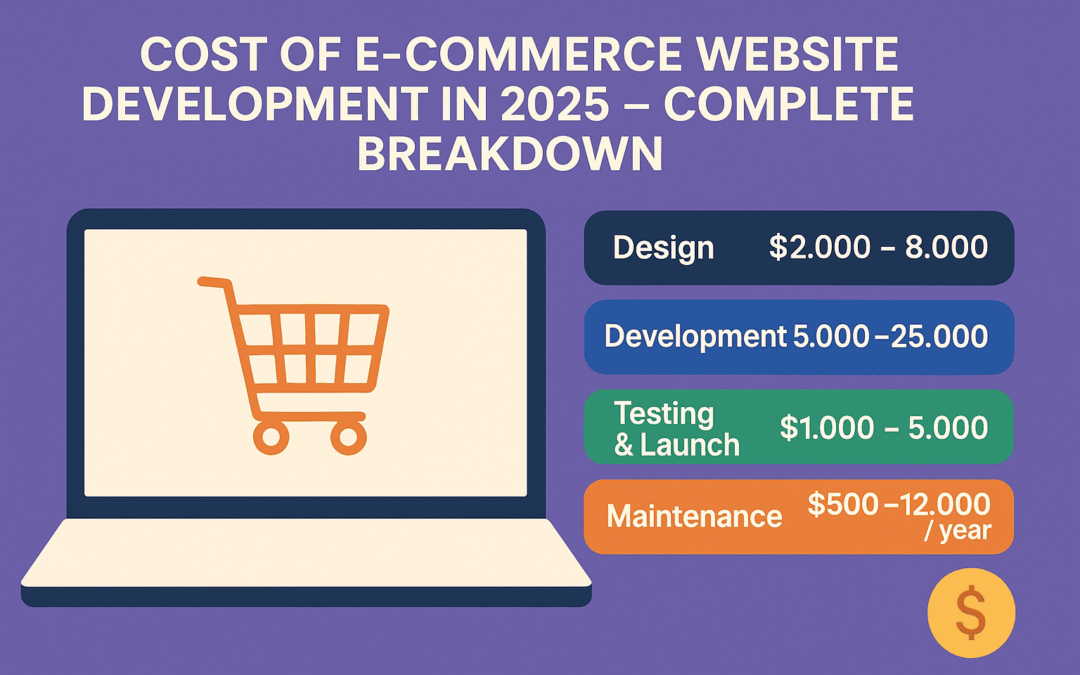If you’re planning to launch an online store in 2025, one of the first questions you might have is: “How much does it cost to develop an e-commerce website in 2025?” The answer isn’t straightforward because pricing depends on several factors like platform choice, features, design complexity, and development resources.
In this blog, we provide a comprehensive, human-generated guide to help you understand what goes into e-commerce website development costs in 2025 — and how to plan your budget accordingly.
Why E-commerce Websites Are Booming in 2025
The global shift to digital commerce has accelerated, especially post-pandemic. In 2025, more businesses — from startups to traditional retailers — are investing in e-commerce platforms to reach wider audiences, improve customer experiences, and increase revenue.
With changing consumer habits and mobile-first shopping behavior, having a modern, scalable e-commerce website is not a luxury — it’s a necessity.
Key Factors That Influence E-commerce Website Development Costs
1. Type of E-commerce Website
- Single-vendor store (e.g., your own products)
- Multi-vendor marketplace (e.g., Amazon-style platforms)
- B2B/B2C portals
Cost impact: Multi-vendor marketplaces are more complex and expensive.
2. Platform Selection
- Hosted solutions (Shopify, Wix, BigCommerce)
- Self-hosted platforms (WooCommerce, Magento, OpenCart)
- Custom-built from scratch (using frameworks like Laravel, React, etc.)
Cost range:
- Shopify: $29 to $399/month (plus themes, apps, and development)
- WooCommerce: Free plugin, but you’ll pay for hosting, themes, and plugins
- Custom solution: ₹2,00,000 to ₹15,00,000+ (depending on features)
3. Design & User Experience (UX/UI)
- Custom design vs. pre-made themes
- Responsive (mobile-first) design
- Interactive elements, animations, or AR/VR (in 2025, these are trending)
Cost impact: Custom UI/UX design can add ₹30,000 – ₹2,00,000 to your budget.
4. Core Features and Functionalities
| Feature | Cost Range (₹) |
| User Registration & Login | ₹10,000 – ₹20,000 |
| Product Catalog Management | ₹15,000 – ₹40,000 |
| Shopping Cart | ₹10,000 – ₹25,000 |
| Payment Gateway Integration | ₹10,000 – ₹30,000 |
| Shipping Module | ₹8,000 – ₹20,000 |
| Order Tracking | ₹10,000 – ₹25,000 |
| Wishlist / Save for Later | ₹5,000 – ₹10,000 |
| Discount Codes / Coupons | ₹8,000 – ₹15,000 |
| Reviews & Ratings | ₹5,000 – ₹10,000 |
5. Admin Panel Features
- Inventory management
- Analytics dashboard
- Order and refund handling
- Staff accounts and permissions
Estimated cost: ₹25,000 – ₹75,000
6. Third-party Integrations
- CRM tools
- Email marketing platforms
- WhatsApp Business API / Chatbots
- ERP systems
Cost impact: ₹10,000 – ₹50,000 per integration depending on complexity.
7. SEO & Digital Marketing Readiness
- SEO-friendly URLs
- Meta tag management
- Blog integration
- Schema markup
Cost range: ₹10,000 – ₹30,000 for initial setup
8. Security Features
- SSL certificate
- Firewall & malware protection
- GDPR compliance
Cost range: ₹5,000 – ₹20,000
9. Mobile App Development (Optional)
In 2025, many businesses also opt for Android/iOS apps linked to their website.
- Hybrid app (using Flutter, React Native): ₹80,000 – ₹2,50,000
- Native apps: ₹2,00,000 – ₹5,00,000+
10. Maintenance & Support
- Monthly updates, backups, bug fixes
- Server and hosting renewal
Ongoing cost: ₹2,000 – ₹15,000/month (varies by scale)
E-commerce Website Development Cost Summary in 2025
| Component | Estimated Cost Range (INR) |
| Platform | ₹0 – ₹4,00,000 |
| UI/UX Design | ₹30,000 – ₹2,00,000 |
| Core Features | ₹1,00,000 – ₹5,00,000 |
| Integrations | ₹20,000 – ₹1,00,000 |
| Mobile App (Optional) | ₹80,000 – ₹5,00,000 |
| Security & Compliance | ₹5,000 – ₹20,000 |
| SEO Setup | ₹10,000 – ₹30,000 |
| Maintenance (Annually) | ₹24,000 – ₹1,80,000 |
Total Cost Range: ₹2,00,000 to ₹15,00,000+ (depending on scope)
Cost-Saving Tips for E-commerce Startups in 2025
- Start with MVP (Minimum Viable Product)
Focus on launching with essential features. Add advanced features as you scale. - Use Open-Source Platforms
WooCommerce or OpenCart can reduce licensing costs. - Opt for Pre-built Themes with Minor Customization
This reduces design costs while maintaining a good look and feel. - Outsource Development to Reliable Agencies/Freelancers
Especially in regions like India, quality work is more affordable. - Use SaaS Tools for Integrations
Instead of building custom CRMs or email tools, integrate with Mailchimp, Zoho, etc.
Final Thoughts
In 2025, the cost of building an e-commerce website varies widely based on your vision, platform, and features. Whether you’re a small retailer or an enterprise, planning your e-commerce investment smartly can help you launch a powerful online store without breaking the bank.
To get an accurate estimate tailored to your business, it’s best to consult with a web development agency that understands your goals, industry, and future growth potential.


Recent Comments